Music • Photography • Writing
National Parks Of The American Rockies
Glacier
Page
1
Page
2
Page
3
Page
4
Page
5
Page
6

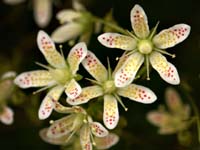
Flowering plants and insects developed simultaneously millions of years ago, and their lives have been interwoven ever since. This tiny spotted saxifrage, shown here about twice life size, guides bees and flies to its nectaries using a very elaborate and beautiful series of tiny colored spots that range from magenta through red, orange, and yellow.
Matahpi Peak towers over Siyeh Bend across from Piegan Pass, where I took this shot. If you look close, one of the rocks in the foreground is actually a hoary marmot, a year-round resident of this rocky, wind-swept alpine country. The word "hoary" doesn't refer to any moral failing, but rather refers to the grayish fur on the back of the marmot's neck. Compare this photo to that of the yellow-bellied marmot in the Tetons. (The term "yellow-bellied" refers to their bellies, not their courage. Marmots can't seem to catch a break.) This family group warned me of the approach of some horses.
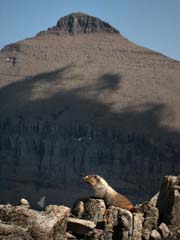
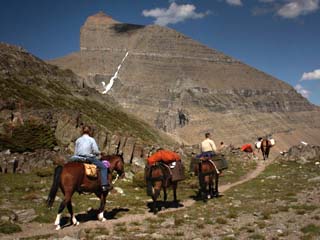
When I first saw these horsemen, I assumed they were one of the trail ride groups I'd seen saddling up at Many Glacier, judging by the lack of headgear that usually marks a dude. As it turned out, they were very experienced riders, most of them native Montanans, who had started at the Canadian border and were riding to the southern border of the park, which would take them a couple of weeks.
Their leader, the man in the blue shirt, said that the trail they had just come up was the roughest stretch he'd ever done, and that included the Bob Marshall Wilderness to the south of the park, one of the largest remaining stretches of wilderness in the lower 48 states. I'll vouch for the fact that the wind was blowing a steady sixty miles an hour or so, with even stronger gusts, which carried their hats across the valley before they could dismount to catch up with them. One of the horses had partially thrown a shoe on the steep, slippery shale of the trail, where a slip easily could be fatal to both horse and rider. But they were in good spirits and their sturdy horses and obstreperous mules waded through the deep snowbanks with ease.
As I said earlier, winter never seems far away in Glacier. Here, a young raspberry bush seems to show fall colors even on brand-new leaves. Actually, the reddish tinge in these leaves comes from pigments that act as sun block to protect the delicate tissues. The raspberries on the eastern slope and the huckleberries in the western part of the park are the major food source for the bears, other than careless hikers. I generally sing loudly when I'm hiking alone in bear country. So far my singing career hasn't taken off with bears any more than it has with humans, but I'm not sure I want to attract a crowd of either one.
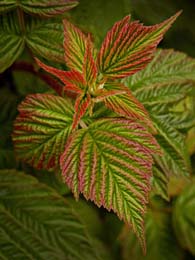
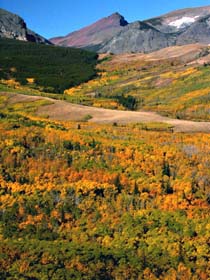
Eventually, though, fall comes for real, bringing fresh snow to the high peaks and turning the huge stands of aspen on the eastern slope of the park yellow, gold, and red. (Aspens are connected underground, so what appears to be a number of trees may be only one, which helps explain the large patches of color on the slopes.) On the east, the park borders on land belonging to the Blackfeet Nation, who once had this whole area to themselves. They are still actively involved in maintaining and caring for the park. Their good stewardship is evident in the unspoiled condition of the land; we have a lot to learn from people who are in it for the long haul.
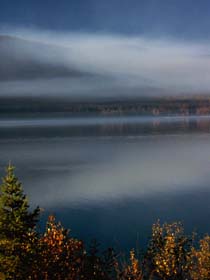
Fall also often brings forest fires, especially in dry years. Unlike the case in Yellowstone, where well-meaning park personnel and ill-informed politicians decided to suppress the natural fire cycle, Glacier has had little interference from man, so the fires, while still extensive at times, don't cause the kind of severe damage that the 1988 fires in Yellowstone caused. Here you can see smoke still rising from the burnt trees on the far shore of Lake McDonald. If you look close, you can also see the smoke from last night, which, having cooled and grown heavier, seeps out across the lake. In the foreground are birch trees in fall color.
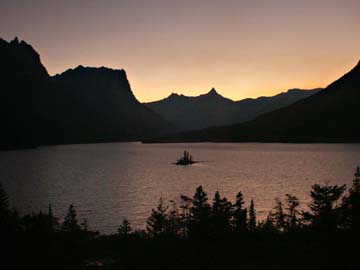
In his plea to Congress to set aside Glacier as a national park, George Grinnell described it as the "Crown of the Continent." The description is apt. Triple Divide Peak forms the watershed for streams flowing to the Pacific Ocean, the Gulf of Mexico, and Hudson's Bay in Canada. Glacier is also an intersection of several different ecosystems, resulting in some of the greatest natural diversity in North America.
Part of the purpose of the Lewis and Clark's Corps of Discovery was to establish the border between Canada and the United States. (The Marias River, into which flows Two Medicine Creek, is named for Lewis's lady friend.) When they first saw this range, they called it the "Rocky Mountains," and the name stuck for the entire cordillera that stretches from Alaska into Mexico. (They also named the grizzly bear, with which they became all too familiar. The "grizzly" part comes from the bears' lighter, grayish fur, not from any grisly habits.)
Glacier has a sister park across the border in Canada, Waterton National Park, which together form Waterton/Glacier International Peace Park, the only trans-national park in the world and a tribute to the long-standing good relations between the two neighbors. Perhaps it takes a place as special as Glacier to remind us that, for all our differences, we all share this beautiful and ever-changing planet.
